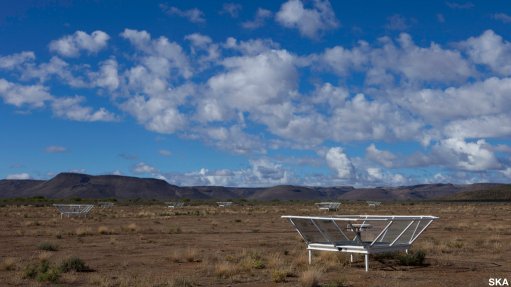
Photo by: SKA
Scientific studies completed using the Precision Array to Probe the Epoch of Reionisation (Paper), one of the world-class scientific instruments in South Africa's Karoo Radio Astronomy Reserve, which is producing ground-breaking science and “spectacular” cosmic images, are resulting in several articles in top astronomy journals.
Scientists at South Africa’s Square Kilometer Array (SKA) project explained that the primary goal of Paper was to detect emissions from the neutral gas that pervaded the universe before the first galaxies and black holes were formed.
This 'epoch of reionisation', as it is called, is the last frontier in observational cosmology.
Recent observations with Paper were used to set the first physically interesting limits on emissions from the neutral hydrogen during this key epoch in cosmic structure formation.
Apart from providing important constraints on the early evolution of the universe, these observations were helping to define the techniques and instrumentation that would translate into the design of a next-generation Hydrogen Epoch of Reionisation Array, and, eventually, the low-frequency SKA.
Beyond the cosmological studies, Paper had produced unprecedented images of the southern radio sky at low frequency, as it comprised a unique combination of wide field, reasonable spatial resolution, and wide frequency range.
“Spectacular images of the closest powerful radio galaxy, Centaurus A, have been made with Paper, revealing a very large structure in this giant radio galaxy, some 200 kiloparsec (kpc) in extent. This is ten times the size of the entire Milky Way,” the SKA South Africa (SA) office said on Friday.
A kpc is a unit of measurement used by astronomers to measure distances between parts of a galaxy, or within groups of galaxies, where one kpc was equal to 3 000 light years.
The Paper data provided further insight into the interaction between these giant radio “jets” emanating from the massive black hole at the centre of the Centaurus A galaxy, with the large-scale intergalactic medium surrounding the galaxy.
Paper team member and chief scientist at the US National Radio Astronomy Observatory Chris Carilli emphasised that the help of the SKA SA project office, and the intern student support for work in the Karoo, had been fundamental to the success of Paper.
“The Karoo has now been established as a world-leading site for studies of the radio cosmos. We look forward to the coming years, as the collaboration matures with next-generation instruments in the Karoo, leading to profound insights into the nature of the universe,” he commented.
SKA SA Paper project manager William Walbrugh noted that the instrument, in concert with site infrastructure and support, showed remarkable stability, with no interruption during a recent six-month observation window.
“Hosting Paper successfully confirms the integrity of the South African SKA site, as well as the technical expertise of the South African team," added SKA SA science and engineering associate director Professor Justin Jonas.